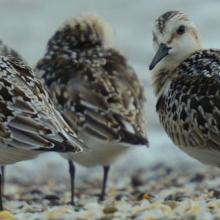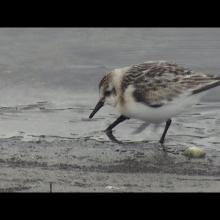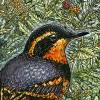

Join BirdNote tomorrow, November 30th!
Illustrator David Sibley and actor H. Jon Benjamin will face off in the bird illustration battle of the century during BirdNote's Year-end Celebration and Auction!
How do birds fare before a storm? Patrick Comins of Audubon Connecticut says, "Seabirds try to avoid a hurricane if they can, but sometimes end up getting blown off course. Most landbirds are pretty tuned in to weather changes. Whenever there's a storm approaching, you'll notice a lot of frenzied activity at your feeders." And after the storm? "I noticed that there were still quite a few flocks of migrant shorebirds at Long Beach West in Stratford, including Dunlin and Sanderlings (like these). They just seemed more stressed than normal, frenzied in their foraging, at the tide line… just focused on feeding. You could kinda get the sense that they went through a little bit of a rough time."
BirdNote®
Birds Respond to a Storm - With Patrick Comins
By Chris Peterson
This is BirdNote!
[Strong wind + Brian Williams of NBC “…A history-making East Coast storm – Hurricane Sandy — the lowest recorded barometric pressure…of any storm in the Atlantic…”]
How do birds fare when barometric readings plummet and winds blow 50 to 80 miles per hour? We asked Patrick Comins, Director of Bird Conservation for Audubon Connecticut:
“Well if they’re in the air, most of the birds are in trouble. It’s mostly the seabirds… because they’re pretty hardy birds and will fly around in heavy winds – they’ll try to avoid a hurricane if they can, by going around ‘em but sometimes that means that they end up getting sucked in to a vortex and blown off course.”
Way off course – like the Herald Petrel, a seabird, found in central Pennsylvania.
And land birds?
“Most land birds are pretty tuned in to weather changes…. whenever there’s a storm approaching, you can look at your feeders and you’ll notice a lot of frenzied activity. …Up to about two days before the storm we had about 200 Pine Siskins here – they are famously nomadic, they’ll move all over the continent in search of food. All of a sudden that flock just disappeared before the storm. I suspect birds can detect barometric pressure changes – and realize that something was coming – they fattened up – were frantic at the feeders and left before it came.”
And what about after the storm?
“I noticed on my …damage assessment survey… there were still quite a few flocks of migrant shorebirds at Long Beach West in Stratford, including Dunlin and Sanderlings and Black-bellied Plovers and they just seemed more stressed than normal…. They were …frenzied in their foraging behavior, at the tide line… just focused on feeding. You could kinda get the sense that they went through a little bit of a rough time.”
To learn more, begin at birdnote.org.
###
"NBC Nightly News with Brian Williams" November 1, 2012
Producer: John Kessler
Executive Producer: Chris Peterson
© 2012 Tune In to Nature.org December 2012 Narrator: Michael Stein
ID# hurricane-05-2012-12-12
Marantz IV track105 and track 130









